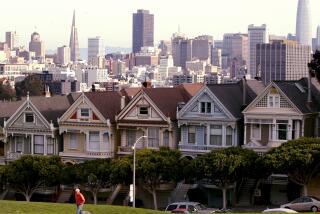Column: California desperately needs affordable housing — but also a new blueprint for building it

- Share via
Kate Vershov Downing is a lawyer working for a Silicon Valley technology firm, married to a software engineer. But even with two good jobs in the household, she’s been driven out of the Palo Alto housing market, where the home she rents with another couple costs $6,200 in monthly rent and would cost $2.7 million to buy.
The Downings are moving to Santa Cruz, where prices are somewhat less nuts.
“If professionals like me cannot raise a family here, then all of our teachers, first responders and service workers are in dire straits,” she wrote recently in a regretful letter of resignation from the Palo Alto Planning and Transportation Commission. “We already see openings at our police department that we can’t fill and numerous teacher contracts that we can’t renew because the cost of housing is astronomical not just in Palo Alto but many miles in each direction.”
This governor has never seen a CEQA exemption he doesn’t like.
— Kathryn Phillips, Sierra Club California
Downing’s dilemma may be an extreme case, given the otherworldly housing market in Palo Alto and other Silicon Valley communities. But it’s replicated across the state, where more than one-third of homeowners and nearly half of all renters are spending more than a third of their household incomes on housing — the official federal definition of “affordable” — and the rate of homelessness easily outstrips that of the nation as a whole.
One cause of the affordability crisis is that the state isn’t building enough housing at any price. Construction in the state isn’t keeping up with population growth, so housing costs rise across the board. That trend creates further ripples, driving up costs of goods, services and employment. A dollar buys less in California than in almost any other state, and housing costs are a major reason.

So it’s proper that Gov. Jerry Brown proposed a solution to the crisis. But it’s unfortunate that his plan plays right into the concerns that many in the environmental and civic planning communities have with the governor, including his apparent willingness to sideline far-reaching policies for short-term or narrow gains.
As my colleague Liam Dillon has explained, Brown’s plan essentially would grant housing developers a pass on environmental and local planning reviews if 5% to 20% of the units are reserved for low-income or affordable housing. The proposals would be eligible for fast-track approval if they met several other requirements: To be eligible for so-called by-right approval, they would have to be multi-family developments in urban neighborhoods and conform to local general development plans and zoning laws. In announcing the plan in May, Brown tied it to a promise of $400 million for housing subsidies.
In a sense, the governor’s plan acknowledges that the state is out of ammunition for sparking the construction of new housing for middle- and low-income families. Bond issues approved by voters in 2002 and 2006 provided nearly $4 billion to build or rehabilitate more than 57,000 units for such households, but nearly all the money has been spent.
Community redevelopment agencies were required to set aside 20% of their revenues for the same purpose, a mandate that yielded more than $1 billion statewide in 2009-10. But that source evaporated after 2011, when Brown eliminated the redevelopment agencies, which he said were wasteful and ineffective at fostering economic growth.
The administration portrays the new proposal as a way to “streamline” local and environmental planning, reducing bureaucratic and nuisance delays in the teeth of the crisis.
“Some people who come and protest new development have owned their home since the ’60s and ’70s,” says Downing. “They’re people who used to work as teachers, and now they’re drawing up the bridge behind them,” driving up prices to the point beyond what they could have afforded themselves. Brown’s solution, she contends, “does everything that needs to happen.”
The problem is that what looks like red tape and nuisance lawsuits to a real estate developer can serve as crucial and all-too-rare opportunities for input for neighbors and local officials. Local leaders question whether the streamlined process would give planners sufficient time to examine the impact of “by right” developments on traffic, light pollution, noise and civic services.
“Our residents expect to have a forum where they can express their views and try to mitigate these environmental issues wherever possible,” says Dan Carrigg, deputy director for legislative affairs of the League of California Cities. Labor organizations see the planning process as an opportunity to ensure union-scale wages for construction workers.
“Without the ability to engage on wages,” says Robbie Hunter, president of the State Building and Construction Trades Council, “they would go straight to the bottom.”
Some environmentalists see the governor’s plan as another expression of his hostility to the far-reaching California Environmental Quality Act, or CEQA, which requires detailed environmental impact reviews of construction projects.
Brown says CEQA is among the California conditions that make it “easier to build in Texas,” but is hard to change because of the “political climate,” as he told Jim Newton of the civic magazine Blueprint. “The unions won’t let you because they use it as a hammer to get project labor agreements,” he said. “The environmentalists like it because it’s the people’s document that you have to disclose all the impacts.”
Brown has attempted to deal with CEQA by advocating case-by-case exemptions; says Kathryn Phillips, director of the Sierra Club California, “This governor has never seen a CEQA exemption he doesn’t like.” Carving housing projects out of the CEQA process, she says, would simply serve developers’ purposes in “building as quickly as possible with as little oversight as possible.”
Even some affordable housing advocates who agree the approval process for housing is too prolonged question whether the governor’s proposal is entirely the right solution.
“We need 1.5 million affordable units in California, so we have to revisit the process so it moves faster,” says Christian Ahumada, executive director of Clifford Beers Housing, a Los Angeles nonprofit that has 448 homes and 310 apartments built or in the planning stages, chiefly for disabled persons, veterans, seniors, families and homeless youth. “We do need to streamline it, but we can’t cut out community input.”
Some argue the proposed threshold for “by right” exemptions is too low and the definition of “affordable” too lax — according to the federal government, it means housing that costs no more than 30% of household income, including utilities. That isn’t necessarily the same as low-income housing.
In Hollywood, where median household income is about $33,700, the “affordable” threshold in monthly rent or mortgage would be less than about $850. But in Santa Monica, where the median household income is nearly $70,000, an affordable home would rent for or carry a mortgage of about $1,750 a month. That mortgage payment could cover a home costing close to $500,000.
Allowing developers to sidestep local planning reviews in return for a handful of lower-priced units would mean “getting too little back for what we’re giving away,” says Los Angeles County Supervisor Sheila Kuehl. “We get fooled because we call something ‘affordable’ if it’s just not at the market rate. This is the worst way to get affordable housing.”
Yet this all avoids the question of what is the right way. A measure making its way through the Legislature would place a $3-billion affordable housing bond on the ballot as early as this November, but that money alone may not be enough to get housing where it’s needed.
The burdensome permitting process for new construction should be streamlined, but not in a way that cuts local communities out of the loop to the extent Brown advocates. A good plan would recognize that laws like CEQA have helped make living in California as alluring as it is, and shunting them aside won’t, in the end, get the state what it needs. The governor’s proposal is sound in principle, but it’s the first draft of a workable blueprint.
Keep up to date with Michael Hiltzik. Follow @hiltzikm on Twitter, see his Facebook page, or email [email protected].
Return to Michael Hiltzik’s blog.
MORE FROM MICHAEL HILTZIK:
How the criminal conviction of PG&E lets the real wrongdoers go free
It’s time for the government to play hardball with those whining Obamacare insurers
Donald Trump just proposed repealing the ‘death tax.’ Here’s why that’s a scam.
More to Read
Get the L.A. Times Politics newsletter
Deeply reported insights into legislation, politics and policy from Sacramento, Washington and beyond. In your inbox three times per week.
You may occasionally receive promotional content from the Los Angeles Times.











